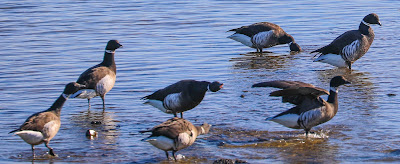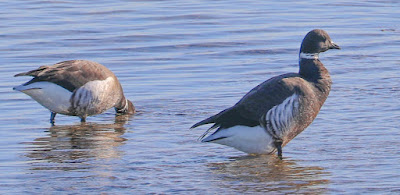The brant is a small goose with three subspecies: (a) the dark-bellied brant; (b) the pale-bellied brant (also known as the Atlantic brant in the U.S. and the light-bellied brent goose in Europe); and (c) the black brant (also known as the Pacific brant). The dark-bellied brant breeds in central and western Siberia and winters in southern England, northern Germany and northwestern France. The pale-bellied brant breeds in northeastern Canada and winters along the Atlantic coast from Maine to Georgia. The black brant breeds in northwestern Canada, Alaska and eastern Siberia and winters on the west coast of North America from southern Alaska to California, but some also in Japan, Korea and China.
The black brant, which I've seen twice at Bolsa Chica Ecological Reserve in Huntington Beach, has a dark sooty-brown back and underparts (the dark stretching further underneath than the other two subspecies), a large white flank patch, the largest white neck-patch of the three, almost forming a complete collar, a short black bill, black eyes, black legs and feet, and white underneath the tail.
When I first saw them in early morning light I had no idea what they were and had to ask a person standing nearby what they were. I believe they are fairly uncommon in Southern California.






There's something about them that reminds me of Eastern Europe. Maybe the somber seriousness of their foliage? It's amazing that they can be seen an hour away from us. They like the warm winter just like we do.
ReplyDeleteOf note, on December 22, 1849, while at the Williams Ranch in Chino, Addison Pratt and others went hunting for wild game for Christmas dinner. He noted that geese, brant and ducks were plentiful. Pratt got one brant and two ducks, the only hunter to get anything. But there were plenty of fish that could make up for the other game that was lacking. This was the group that George Q. Cannon was in.
Delete